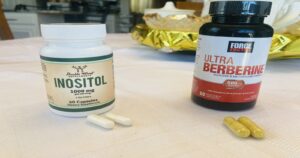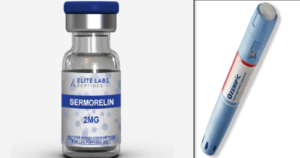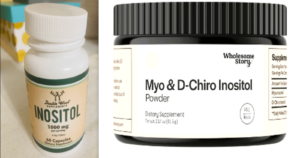Spearmint tea have an anti-androgenic effect, potentially impacting hormone levels that are often imbalanced in PCOS. Peppermint tea, on the other hand, is more commonly known for its digestive benefits and soothing properties. It provide relief for some symptoms like bloating or indigestion that can accompany PCOS.
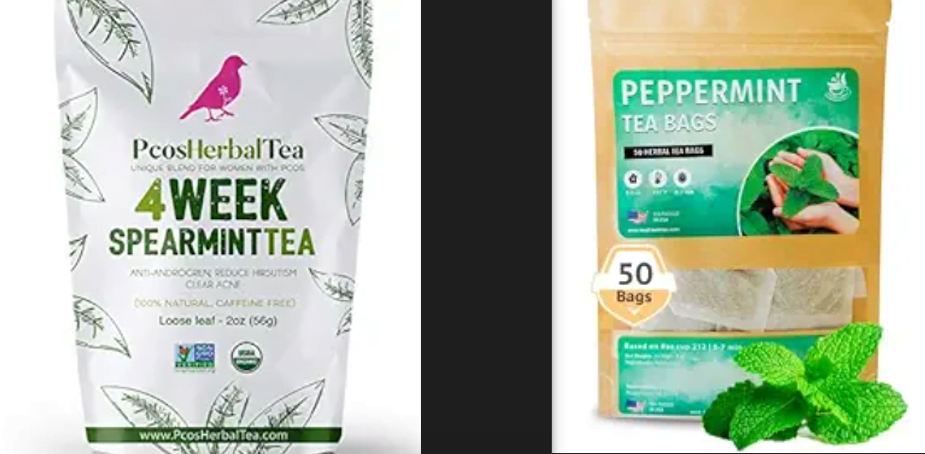
| Spearmint Tea | Peppermint Tea |
|---|---|
| Helps regulate androgen levels | Have a mild effect on hormone balance |
| Improve insulin sensitivity | Potential for improvement insulin sensitivity |
| Help regulate menstrual cycles | Limited evidence, may have mild regulatory effects |
| Contains rosmarinic acid, with anti-inflammatory properties | Contains menthol, offering mild anti-inflammatory effects |
| Contains antioxidants, potentially reducing oxidative stress | Contains antioxidants, aiding in combating oxidative stress |
| Caffeine-free, suitable for individuals with PCOS | Caffeine-free, suitable for individuals with PCOS |
What is Spearmint?

Spearmint is a type of mint plant belonging to the Mentha genus, scientifically known as Mentha spicata. It’s a perennial herb that is widely cultivated for its aromatic leaves, which are commonly used as a culinary herb and for medicinal purposes.
Spearmint (Mentha spicata) is a species of mint known for its aromatic leaves and refreshing flavor. It is commonly used in culinary applications, such as flavoring teas, beverages, and desserts. Spearmint is also utilized for its medicinal properties and is often employed in traditional herbal remedies to alleviate digestive issues and freshen breath.
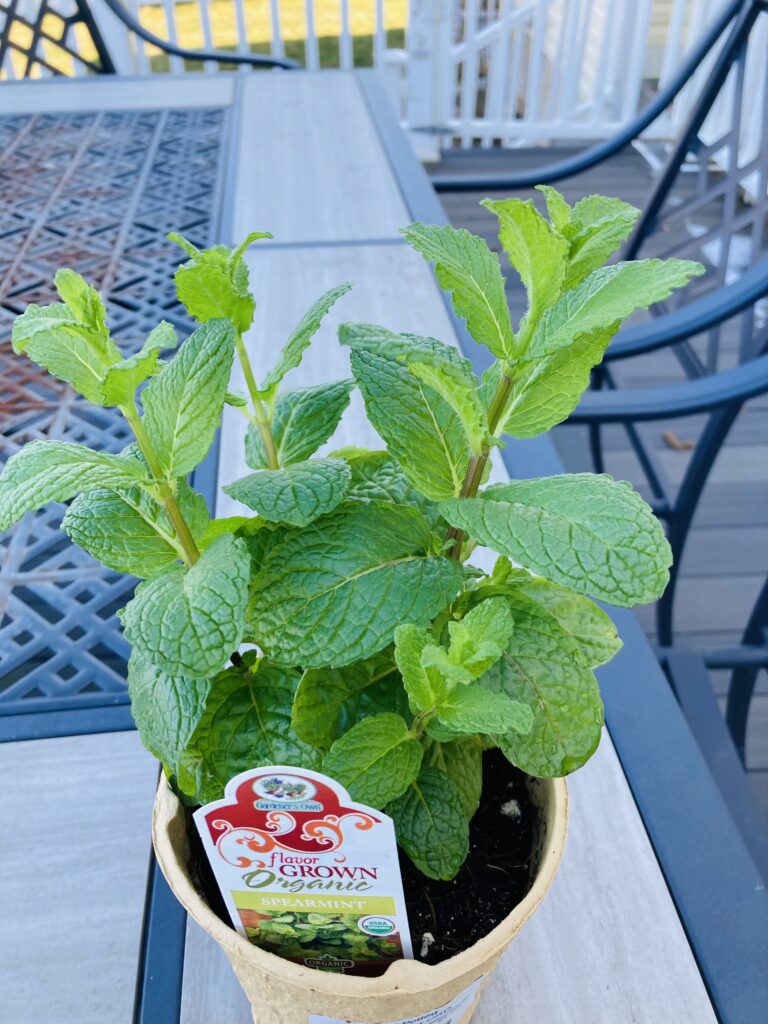
6 Characteristic of the spearmint (Mentha spicata) plant
- Leaves: Spearmint leaves are oval to lance-shaped with serrated edges. They are typically bright green in color and grow in pairs opposite each other along the stem. The leaves are aromatic and emit a refreshing scent when crushed or bruised.

2. Stem: The stem of the spearmint plant is square-shaped and often branched. It is sturdy and can grow to varying heights, typically ranging from 30 to 100 centimeters tall.
3. Flowers: Spearmint produces small, clustered spikes of pale purple to pink flowers at the top of the stems. These flowers are tubular and arranged in whorls around the stem, adding aesthetic appeal to the plant.
4. Aroma: The aroma of spearmint is fresh, sweet, and slightly minty. It is less intense compared to peppermint but still distinctly minty. The fragrance is often used in culinary applications and herbal preparations.
5. Roots: Spearmint plants have fibrous roots that spread horizontally in the soil. These roots anchor the plant and absorb water and nutrients from the surrounding soil to support its growth.
4. Rhizomes: Below the surface, spearmint plants develop underground rhizomes, which are horizontal stems that spread out and give rise to new shoots and roots. Rhizomes enable spearmint to propagate vegetatively and form dense colonies over time.

What is Peppermint?
Peppermint, scientifically known as Mentha × piperita, a cross hybrid of two distinct mint plant, watermint and spearmint. It’s widely known for its refreshing aroma and flavor, often used in culinary applications like teas, desserts, and as a flavoring agent in various food and beverages.
Peppermint is also valued for its medicinal properties, such as its ability to soothe digestive issues, alleviate headaches, and provide relief from nasal congestion when used in products like essential oils or herbal remedies.
Additionally, peppermint is cultivated for its ornamental value in gardens and landscapes due to its attractive foliage and fragrance. Peppermint has dark green leaves with serrated edges and purple-tinged stems. It typically grows to a height of about 30-90 cm (12-35 inches) tall.
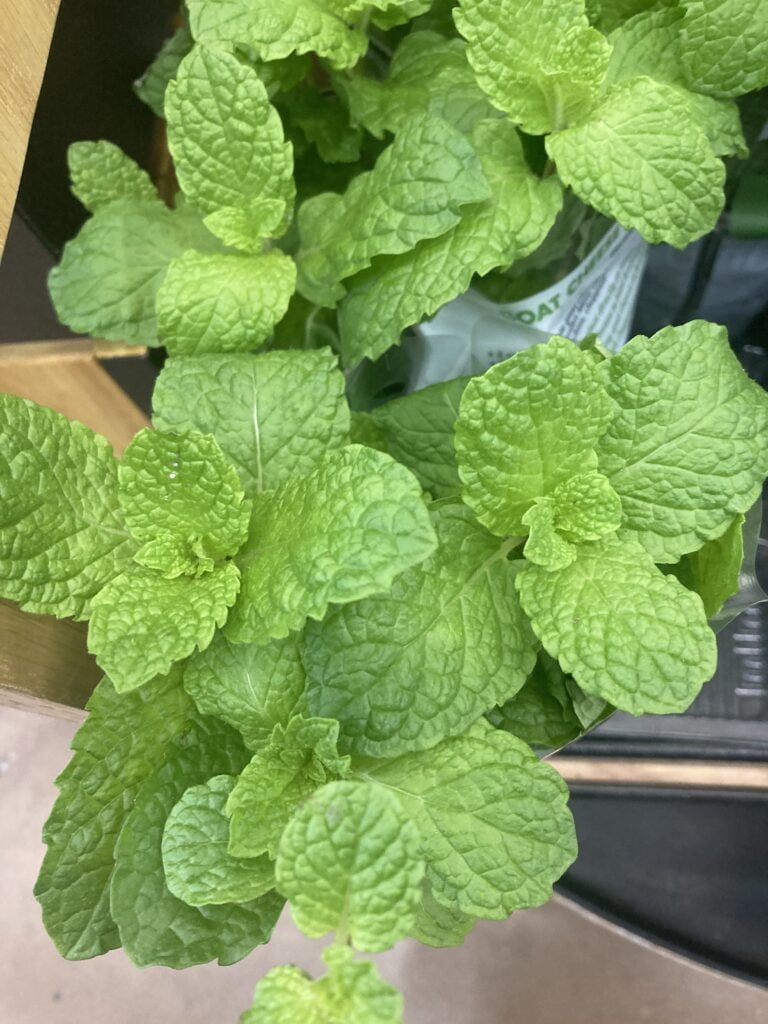
Identifying Spearmint plant from PepperMint plant
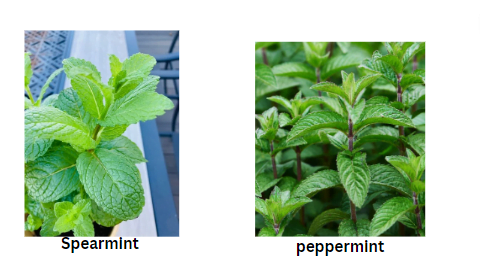
| Spearmint | Peppermint |
|---|---|
| Leaf Shape: Narrow, pointed | Leaf Shape: Rounded, broader |
| Leaf Color: Bright green | Leaf Color: Dark green with purple hues in some varieties |
| Stem Color: Green | Stem Color: Purple-ish hue, especially in younger stems |
| Stem Shape: Square-shaped, but less pronounced | Stem Shape: More pronounced square shape |
| Preferred Growing Conditions: Thrives in partial shade and moist soil | Preferred Growing Conditions: Prefers full sun and well-drained soil |
| Medicinal Uses: Known for its digestive and calming properties | Medicinal Uses: Often used for respiratory and sinus issues |
| Root: Typically shallow, spreading horizontally | Root: Generally deeper, taproot-like |
Description of peppermint plant
Peppermint is a perennial herb with a square stem and bright green serrated leaves. It typically grows in a spreading manner and can reach heights of up to 1-3 feet (30-90 centimeters). The leaves are lance-shaped and emit a strong, refreshing minty aroma when crushed or bruised.
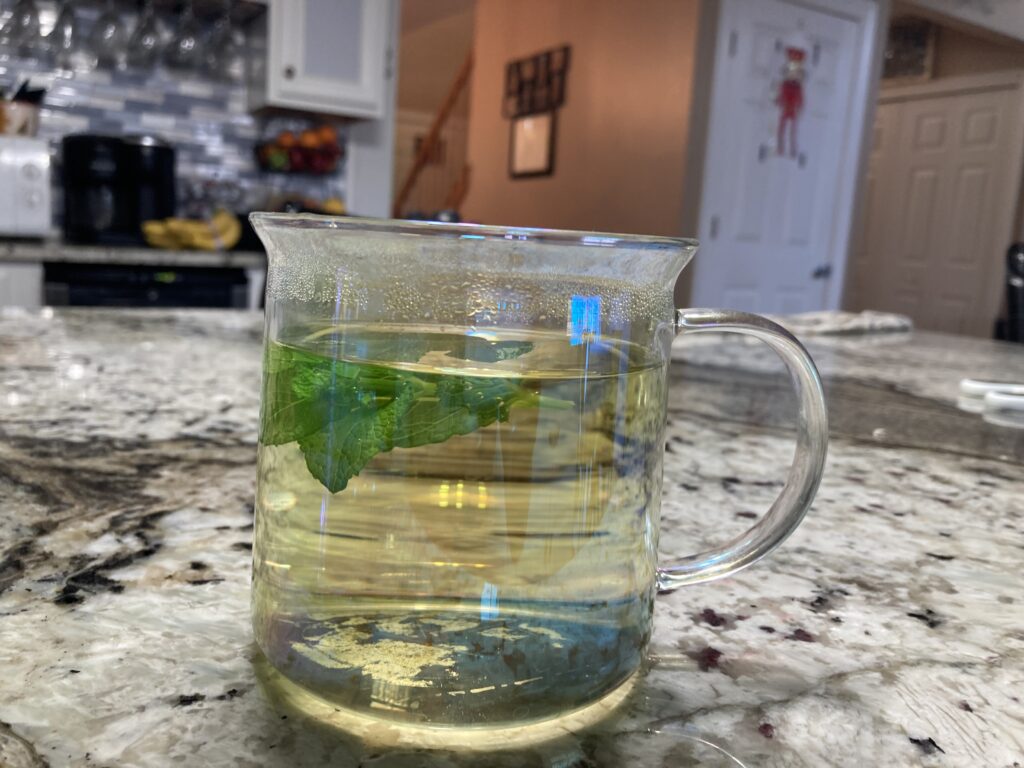
Peppermint produces small, purple flowers clustered in terminal spikes at the top of the stems during the summer months. These flowers are attractive to pollinators like bees and butterflies.
The plant has a characteristic minty flavor that is both cooling and invigorating, with hints of sweetness and a subtle spiciness. This flavor is due to the presence of menthol, which is a compound found in the essential oil of peppermint.
Peppermint is commonly grown in gardens, but it can also be found growing wild in temperate regions around the world. It is known for its versatility and is used in various culinary, medicinal, and cosmetic applications.

How Spearmint tea and Peppermint tea influence hormonal balance:
Spearmint and peppermint teas have gained attention for their potential to help regulate hormones, particularly androgens like testosterone, which can be elevated in conditions such as Polycystic Ovary Syndrome (PCOS).
1. Anti-Androgenic Properties: Spearmint and peppermint teas contain compounds that exhibit anti-androgenic effects, meaning they can help reduce the levels or activity of androgens in the body. One such compound is Rosmarinus acid, found in both spearmint and peppermint, which has been studied for its ability to inhibit the enzyme 5-alpha reductase. This enzyme converts testosterone to dihydrotestosterone (DHT), a more potent androgen. By inhibiting this enzyme, these teas may help lower androgen levels.

2. Regulation of Hormone Production: Mint teas may also influence hormone production in the body. Studies suggest that spearmint tea, in particular, may affect the secretion of hormones such as luteinizing hormone (LH) and follicle-stimulating hormone (FSH), which play crucial roles in the regulation of ovarian function and hormone balance. By modulating the secretion of these hormones, spearmint tea may indirectly impact androgen levels.
3. Improvement of Symptoms: Some research indicates that consuming spearmint tea regularly may lead to improvements in symptoms associated with hormonal imbalances, such as hirsutism (excessive hair growth) and acne, which are common manifestations of elevated androgens in conditions like PCOS. While more extensive clinical trials are needed to confirm these effects, anecdotal evidence and preliminary studies suggest a potential benefit.
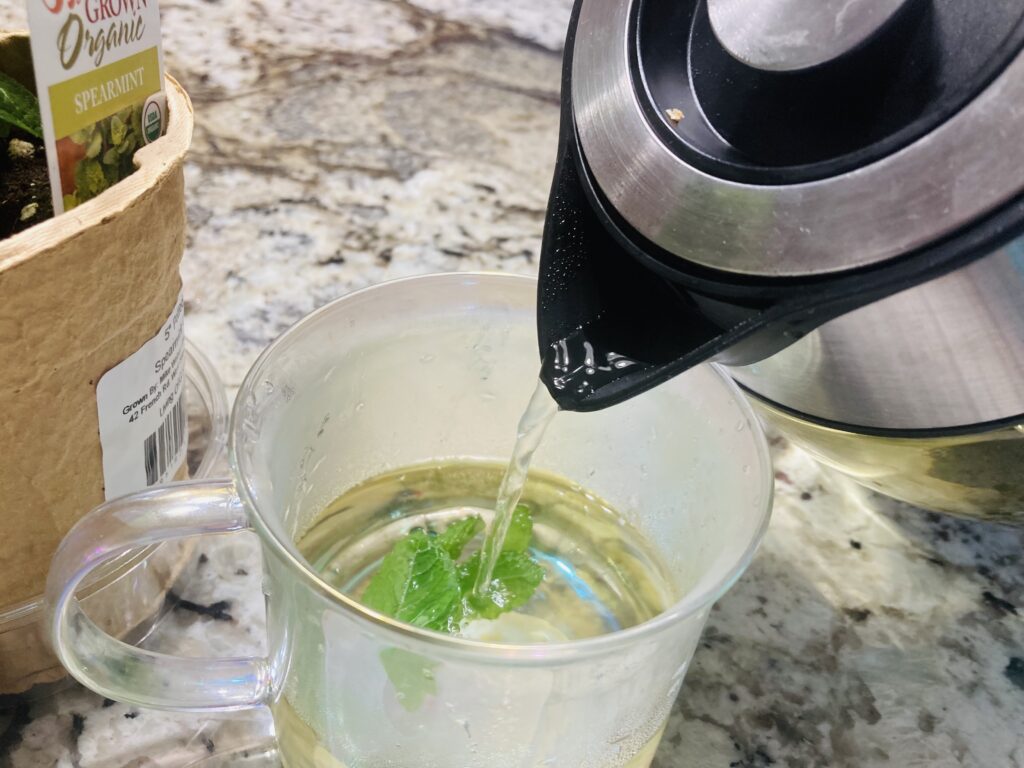
4. Anti-Inflammatory Effects: Both spearmint and peppermint teas possess anti-inflammatory properties attributed to their high content of antioxidants and polyphenols. Chronic inflammation is often associated with hormonal imbalances and conditions like PCOS. By reducing inflammation, these teas may indirectly contribute to restoring hormonal balance.
5. Improvement of Insulin Sensitivity: PCOS is frequently accompanied by insulin resistance, which can exacerbate hormonal imbalances. Some studies suggest that mint teas, particularly spearmint, may help improve insulin sensitivity, which could have positive effects on hormone regulation in individuals with PCOS.
It’s important to note that while spearmint and peppermint teas show promise in supporting hormonal balance, they are not standalone treatments for conditions like PCOS. They can be incorporated as part of a comprehensive approach that includes dietary modifications, regular exercise, stress management, and, in some cases, medication under the guidance of a healthcare professional.

You can find these teas on amazon or Walmart and at any other grocery store
How spearmint tea help reduce symptoms like hirsutism (excessive hair growth) and acne associated with PCOS.
Spearmint tea has gained attention for its potential anti-androgenic effects, particularly in the context of managing symptoms like hirsutism and acne associated with polycystic ovary syndrome (PCOS). While scientific research on this specific topic is still emerging, there are several studies and anecdotal evidence supporting its use.
- Clinical Studies:
- A notable study published in the journal Phytotherapy Research in 2007 investigated the effects of spearmint tea on hirsutism in women with PCOS. The study involved 21 participants who consumed spearmint tea twice daily for five days in the follicular phase of their menstrual cycle. The results showed a significant decrease in free testosterone levels and an improvement in hirsutism scores after the treatment period.
- Another study published in the journal Phytotherapy Research in 2010 examined the effects of spearmint tea on hormonal levels in women with PCOS. The researchers found that spearmint tea consumption led to a significant reduction in total testosterone levels and an increase in luteinizing hormone (LH) and follicle-stimulating hormone (FSH) levels. Elevated LH levels are often associated with PCOS, and reducing them may help improve symptoms.
- While these studies provide promising results, larger randomized controlled trials are needed to confirm the efficacy of spearmint tea in managing PCOS symptoms.

2. Mechanism of Action:
- Spearmint contains compounds such as flavonoids and polyphenols, which are thought to possess anti-androgenic properties. These compounds may inhibit the activity of enzymes involved in androgen production or exert direct anti-androgenic effects on target tissues.
- One proposed mechanism is the inhibition of 5-alpha-reductase, an enzyme responsible for converting testosterone to its more potent form, dihydrotestosterone (DHT). By inhibiting this enzyme, spearmint tea may help reduce the levels of DHT, which is implicated in conditions like hirsutism and acne.

3. Anecdotal Evidence:
- Many individuals with PCOS have reported anecdotal benefits from consuming spearmint tea, including a reduction in hirsutism, acne, and menstrual irregularities.
- While anecdotal evidence should be interpreted with caution and does not substitute for rigorous scientific research, it can provide valuable insights into the potential efficacy of natural remedies.
Safety Considerations when using spearmint tea
Spearmint tea is generally considered safe for consumption when consumed in moderation. However, excessive intake may lead to potential side effects such as digestive issues or allergic reactions in sensitive individuals.
It’s essential for individuals with PCOS to consult with their healthcare provider before incorporating spearmint tea or any other herbal remedy into their treatment regimen, especially if they are taking medications or have underlying health conditions.
while there is promising research and anecdotal evidence supporting the anti-androgenic effects of spearmint tea in managing PCOS symptoms like hirsutism and acne, further studies are needed to elucidate its efficacy and mechanism of action. Nonetheless, it can be considered as a complementary approach in conjunction with conventional treatments under the guidance of a healthcare professional.
Study on Spearmint in Turkey 2009
A study in Turkey found that spearmint tea might help reduce hirsutism in women with PCOS by lowering androgen levels. In a 30-day trial, participants who drank spearmint tea twice daily experienced decreases in testosterone levels and improvements in self-reported hirsutism. However, objective measures of hirsutism didn’t show significant changes, likely because the study duration was short. Longer studies are needed to fully understand spearmint tea’s potential as a natural treatment for hirsutism in PCOS.

Study on Peppermint 2012
Peppermint extract, particularly in alcohol form, has shown promise in protecting against radiation-induced harm. Studies suggest that repeated doses of 100 mg/kg over three days can reduce radiation-related sickness and death. Peppermint’s antioxidant and free radical scavenging properties contribute to its effectiveness against radiation damage. Researchers have noted its potential for radioprotection and chemoprevention, including benefits such as quick bone marrow recovery, boosted immunity, and strong antioxidant effects.
Peppermint has long been known for its ability to alleviate headaches. Consumption of peppermint oil and its derivatives has been associated with headache relief. Studies indicate that using a combination of peppermint and eucalyptus oil can effectively soothe individuals experiencing headache discomfort
Drugs that can interact with spearmint and peppermint
1. Cyclosporine
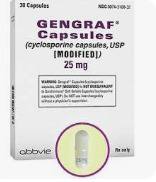
A study done shows that peppermint oil decrease the absorption of cyclosporine, a medication used to prevent organ rejection after transplant surgery.
Peppermint oil interferes with the body’s ability to break down and eliminate cyclosporine, leading to higher levels of the medication in the blood for a longer period of time. This could potentially increase the risk of side effects or toxicity from cyclosporine when taken with peppermint oil.
The time it took for cyclosporine to reach its highest concentration in the blood was delayed when peppermint oil was given. It went from 2 hours to 6 hours.
2. Blood pressure medications
Spearmint and peppermint teas might have a mild hypotensive effect (lowering blood pressure). If you’re taking medications for high blood pressure, monitor your blood pressure levels when consuming these teas, especially in large quantities.
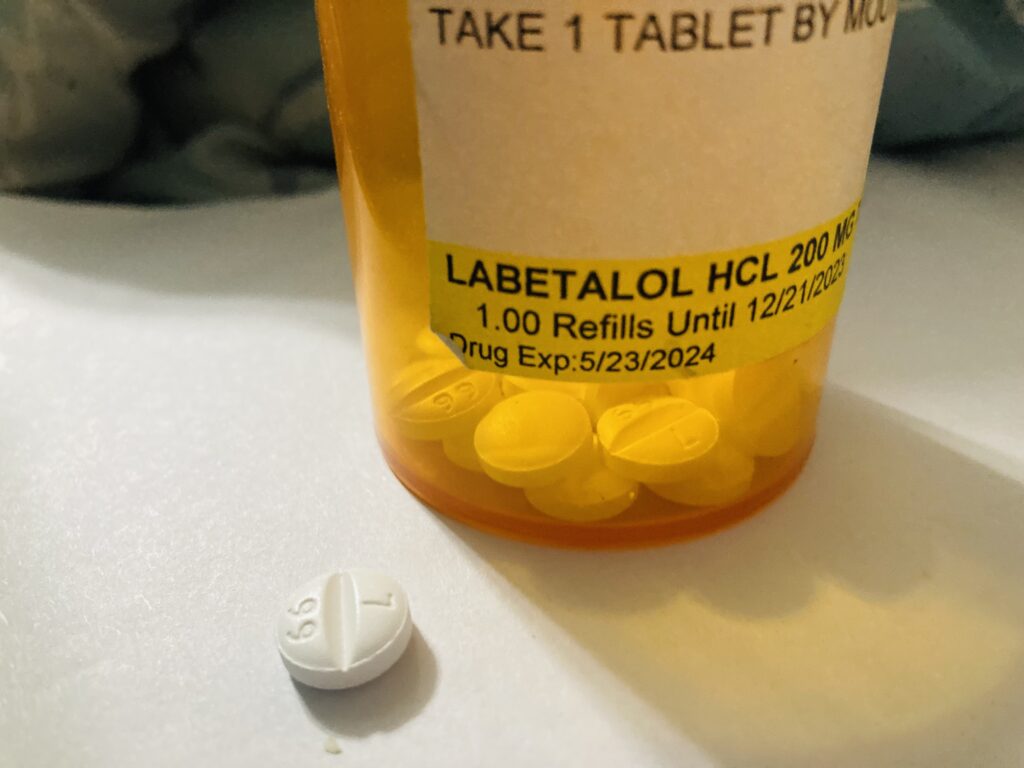
3. Diabetes medications
Spearmint and peppermint teas might affect blood sugar levels, although the evidence is limited. Monitor your blood sugar levels closely if you’re taking medications for diabetes and consuming these teas regularly
4. Antacids
Some antacids contain aluminum, which can bind to the tannins in peppermint tea, potentially reducing its effectiveness.
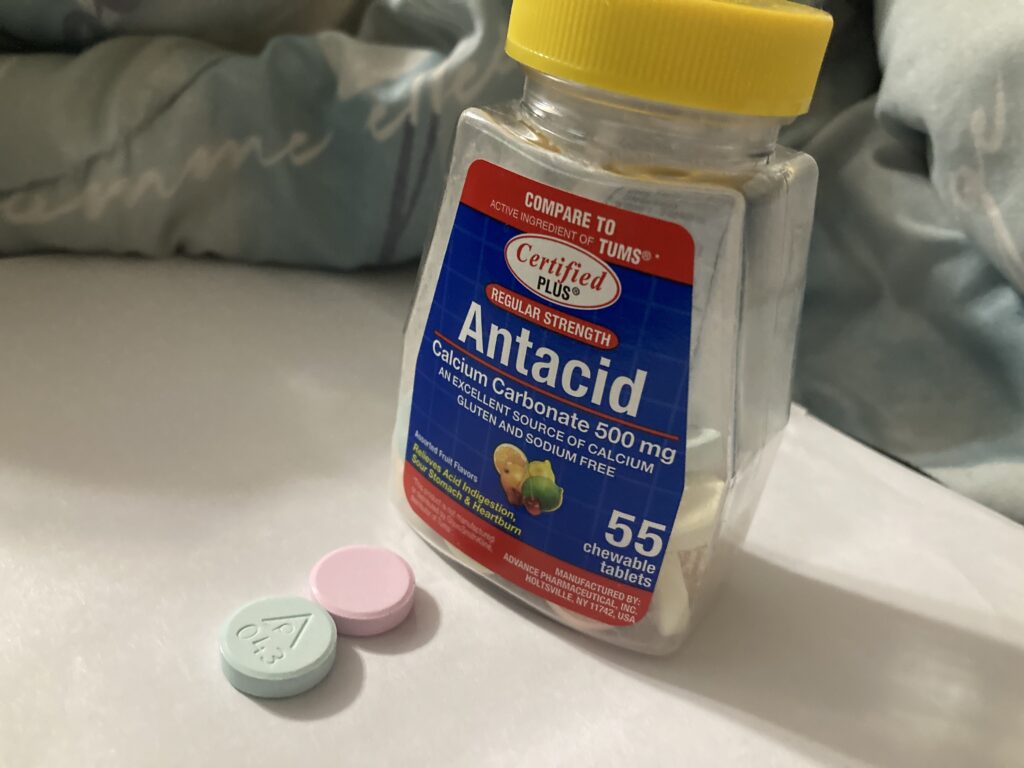
5. Acid reflux medications
Peppermint oil can relax the muscles in the esophagus, potentially worsening symptoms of acid reflux. If you’re taking medications for acid reflux, it’s advisable to avoid peppermint in large amounts.
6. Anticoagulant/antiplatelet drugs
Spearmint and peppermint contain salicylates, which can have mild blood-thinning effects. While this is usually not a concern with normal dietary intake, excessive consumption might theoretically interact with anticoagulant or antiplatelet drugs.
How Spearmint and Peppermint teas influence insulin sensitivity in individuals with PCOS
Understanding why insulin doesn’t work properly in PCOS.
When someone has PCOS (Polycystic Ovary Syndrome), their body might have trouble using insulin properly. Insulin is like a key that unlocks cells so they can use sugar from the blood for energy. But with insulin resistance, the cells don’t respond well to insulin’s signal, so they don’t let enough sugar in. This leads to higher levels of sugar in the blood, which can cause various health issues like weight gain and difficulties with fertility. In PCOS, this insulin resistance often goes hand-in-hand with hormonal imbalances, contributing to the symptoms of the condition.

Spearmint Tea how it works
1. Polyphenols: Spearmint contains polyphenolic compounds such as rosmarinic acid and flavonoids like hesperidin. These compounds have antioxidant and anti-inflammatory properties, which may indirectly influence insulin sensitivity by reducing oxidative stress and inflammation in tissues like adipose (fat) and muscle.
2. Androgen Levels: Spearmint tea has been studied for its potential to lower androgen levels in conditions like polycystic ovary syndrome (PCOS). High androgen levels are associated with insulin resistance, a key feature of PCOS. By reducing androgen levels, spearmint tea might indirectly improve insulin sensitivity.
3. Regulation of Glucose Metabolism: While direct evidence is lacking, some studies suggest that spearmint tea may influence glucose metabolism. Components like rosmarinic acid have been shown to enhance glucose uptake in muscle cells and improve insulin signaling in animal studies.

Peppermint Tea how it works.
- Menthol: Peppermint tea contains menthol, which has been studied for its potential effects on gastrointestinal motility and discomfort. While not directly related to insulin sensitivity, improved digestion and reduced gastrointestinal issues may indirectly benefit metabolic health.
- Anti-inflammatory Effects: Peppermint tea has demonstrated anti-inflammatory properties, primarily due to its high content of menthol and other compounds like menthone. Chronic low-grade inflammation is implicated in insulin resistance, so reducing inflammation may help improve insulin sensitivity.
- Stress Reduction: Peppermint tea is often consumed for its calming effects. Chronic stress can contribute to insulin resistance through various mechanisms including increased cortisol levels and dysregulation of appetite hormones. By promoting relaxation, peppermint tea might indirectly improve insulin sensitivity.
Potential Impacts on the Health of individual with PCOS Symptoms:
- Weight Gain: Improved insulin sensitivity from consuming spearmint and peppermint teas may help mitigate weight gain associated with PCOS by promoting better glucose uptake and utilization in tissues, reducing excessive fat accumulation.
- Irregular Menstrual Cycles: Insulin resistance can disrupt ovarian function and lead to irregular menstrual cycles in PCOS. By improving insulin sensitivity, spearmint and peppermint teas may help restore normal ovarian function and menstrual regularity.
- Androgen Levels: Spearmint tea specifically has been studied for its potential to lower androgen levels in PCOS. By reducing androgen excess, spearmint tea may alleviate symptoms like hirsutism and acne, which are common manifestations of PCOS.
Side effects and Drugs Interaction to consider when drinking Spearmint and Peppermint tea
Both spearmint and peppermint teas are generally considered safe when consumed in moderation, but like any herbal remedy, they may have potential side effects and interactions to consider, especially for individuals with specific health conditions such as PCOS (Polycystic Ovary Syndrome) or others.
| Spearmint Tea | Peppermint Tea |
|---|---|
| Exacerbate hormonal imbalances if taking oral hormone replacement therapy effectiveness | No significant hormonal effects |
| lower androgen levels; affects oral contraceptives | No significant hormonal effects |
| Generally well-tolerated; possible digestive discomfort in some individuals | Known to soothe digestive discomfort, but may worsen symptoms in GERD or cause heartburn |
| Potential for allergic reactions in individuals with allergies to related herbs | Potential for allergic reactions in individuals with allergies to related herbs |
| Interact with medications metabolized by the liver. | Interact with medications metabolized by the liver. |
| Use with caution during pregnancy and lactation due to potential hormonal effects | Generally considered safe in moderation during pregnancy, but excessive intake may pose risks |
| No significant impact on blood pressure | May lower blood pressure; caution advised for individuals with low blood pressure |
| No significant impact on Iron absorption | Inhibit iron absorption; caution advised for individuals at risk of iron deficiency |
Advantages of drinking spearmint tea for women with PCOS

- Hormonal Balance: Spearmint tea may help regulate hormones, specifically androgen levels, which are often elevated in women with PCOS. Spearmint has anti-androgen properties, potentially reducing the levels of testosterone, which can alleviate symptoms like acne, excess hair growth (hirsutism), and irregular menstrual cycles.
- Menstrual Regularity: Some studies suggest that spearmint tea consumption might contribute to more regular menstrual cycles in women with PCOS. This can be particularly beneficial for those struggling with irregular periods or anovulation.
- Reduction of Hirsutism: Spearmint tea could help decrease unwanted hair growth (hirsutism) in women with PCOS. By lowering androgen levels, spearmint may mitigate the excessive hair growth commonly associated with the condition.
- Anti-inflammatory Effects: Spearmint possesses anti-inflammatory properties, which may alleviate inflammation associated with PCOS. This could potentially help mitigate symptoms such as insulin resistance and support overall metabolic health.
- Improved Skin Health: Women with PCOS often experience acne due to hormonal imbalances. Spearmint tea’s anti-androgenic properties may help reduce acne severity by regulating sebum production and decreasing testosterone levels.
- Antioxidant Properties: Spearmint contains antioxidants that can help combat oxidative stress, which is often elevated in women with PCOS. By reducing oxidative stress, spearmint tea may support overall health and potentially mitigate some symptoms of PCOS.
Disadvantages of drinking Spearmint tea for women with PCOS
1. Interactions with Medications: Spearmint tea may interact with certain medications, including hormone therapies or medications metabolized by the liver. It’s essential for women with PCOS who are taking medications to consult with a healthcare professional before adding spearmint tea to their routine to avoid any adverse interactions.
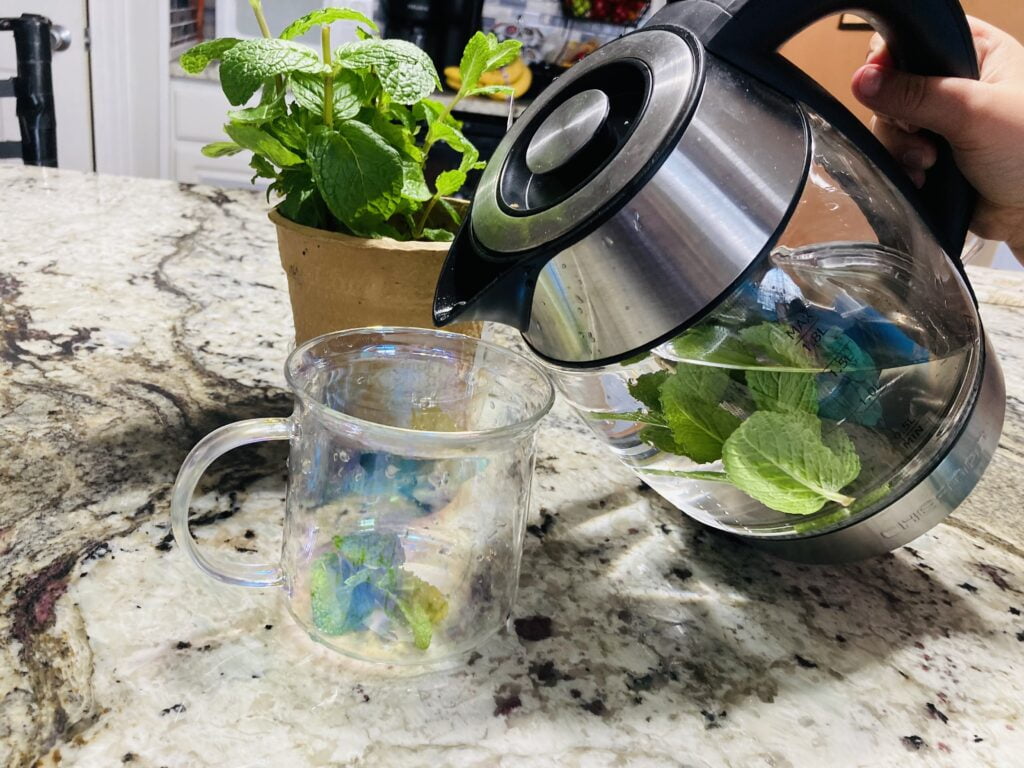
2. Effect on Fertility: While spearmint tea may help regulate menstrual cycles in some women with PCOS, there’s limited research on its effects on fertility. Some women with PCOS may be trying to conceive, and changes in hormonal balance could potentially affect fertility outcomes. Consulting with a healthcare provider is crucial for those actively trying to conceive.
3. Potential Allergic Reactions: As with any herbal remedy, some individuals may be allergic to spearmint or other components of the tea. Allergic reactions could range from mild to severe and may include symptoms such as skin rashes, itching, swelling, or difficulty breathing. It’s essential to discontinue use and seek medical attention if allergic reactions occur.
4. Gastrointestinal Upset: Consuming spearmint tea in excessive amounts or on an empty stomach may lead to gastrointestinal discomfort in some individuals, including bloating, gas, or diarrhea. Moderation and consuming spearmint tea with food may help minimize these effects.
5. Impact on Hormonal Balance: While spearmint tea is often cited for its potential to lower androgen levels, excessive consumption could potentially disrupt hormonal balance in some individuals. Hormonal balance is complex, and altering hormone levels may have unintended consequences. Monitoring symptoms and consulting with a healthcare professional is advisable.
6 Effect on Blood Sugar Levels: Spearmint tea may affect blood sugar levels, although research on this specific aspect is limited. Women with PCOS, particularly those with insulin resistance or diabetes, should monitor their blood sugar levels closely when incorporating spearmint tea into their diet and adjust their treatment plan accordingly.
How long dose it take for Spearmint tea to balance hormones?
In a Cleveland Clinic study, individuals with PCOS drank spearmint tea twice daily. After a month, they had lower testosterone levels and higher LH and FSH levels compared to those who drank a placebo tea. Another study showed improvement in hormonal imbalances after just five days of drinking spearmint tea.
It’s recommended to have one cup of spearmint tea during the day and another before bedtime. Additionally, drinking spearmint tea during the follicular phase of the menstrual cycle has been shown to be beneficial. It helps reduce testosterone levels and boosts the hormones responsible for ovulation.
Lifestyle Factors and Tea Combination Role in PCOS
While teas like spearmint and peppermint may offer potential benefits for managing PCOS symptoms such as hormonal imbalance, they are just one piece of the puzzle. Lifestyle factors such as diet, exercise, and stress management are equally if not more important in effectively managing PCOS.
- Diet: A balanced diet rich in whole foods, fruits, vegetables, lean proteins, and healthy fats can help regulate blood sugar levels, manage weight, and reduce inflammation, all of which are important considerations for PCOS management.
- Exercise: Regular physical activity is crucial for managing weight, improving insulin sensitivity, and reducing the risk of cardiovascular complications associated with PCOS. It also helps in reducing stress levels and promoting overall well-being.
- Stress Management: Chronic stress can exacerbate symptoms of PCOS by increasing cortisol levels and disrupting hormonal balance. Techniques such as meditation, yoga, deep breathing exercises, and mindfulness can be helpful in managing stress levels.
Incorporating these lifestyle factors alongside herbal teas can provide a comprehensive approach to managing PCOS symptoms and improving overall quality of life. It’s important to consult with healthcare professionals for personalized advice and treatment plans tailored to individual needs.
How to Brew Spearmint and Peppermint tea
- Ingredients: You’ll need fresh spearmint leaves and peppermint leaves or dried spearmint leaves and dried peppermint leaves , depending on availability and preference. If you’re using fresh leaves, about 2 tablespoons per cup of water should suffice. For dried leaves, you can use about 1 tablespoon per cup.
- Boil Water: Start by bringing water to a boil. You can use filtered water for the best taste. I usually use filtered water.
- Prepare Leaves: While the water is heating, rinse the spearmint leaves under cold water to remove any dirt or impurities. If you’re using fresh leaves, you can lightly crush them with your hands or a mortar and pestle to release more flavor.
- Steeping: Once the water reaches a rolling boil, remove it from the heat and let it cool for about 1 minute. Pour the hot water over the spearmint leaves in your teapot or cup.
- Steep Time: Let the spearmint leaves steep in the hot water for about 5-7 minutes. This allows the flavor to fully infuse into the water. If you prefer a stronger tea, you can steep it for a bit longer.
- Strain: After the steeping time is up, strain the tea to remove the leaves. You can use a fine mesh strainer or a tea infuser to catch any bits of leaves.
- Serve: Pour the freshly brewed spearmint tea into cups and enjoy! You can sweeten it with honey or sugar if desired, although spearmint tea and peppermint tea is often enjoyed without any added sweeteners.
- Optional Additions: If you want to get creative, you can add other ingredients like lemon slices or ginger for extra flavor. Just add them to the tea while it’s steeping.
Remember, the strength of the tea can be adjusted by varying the amount of spearmint leaves and the steeping time. Feel free to experiment until you find the perfect balance for your taste preferences!
Resources
https://en.wikipedia.org/wiki/Peppermint
https://onlinelibrary.wiley.com/doi/abs/10.1002/ptr.2074
https://pubmed.ncbi.nlm.nih.gov/19585478/
https://www.phytojournal.com/archives/2020/vol9issue3/PartY/9-3-248-685.pdf


